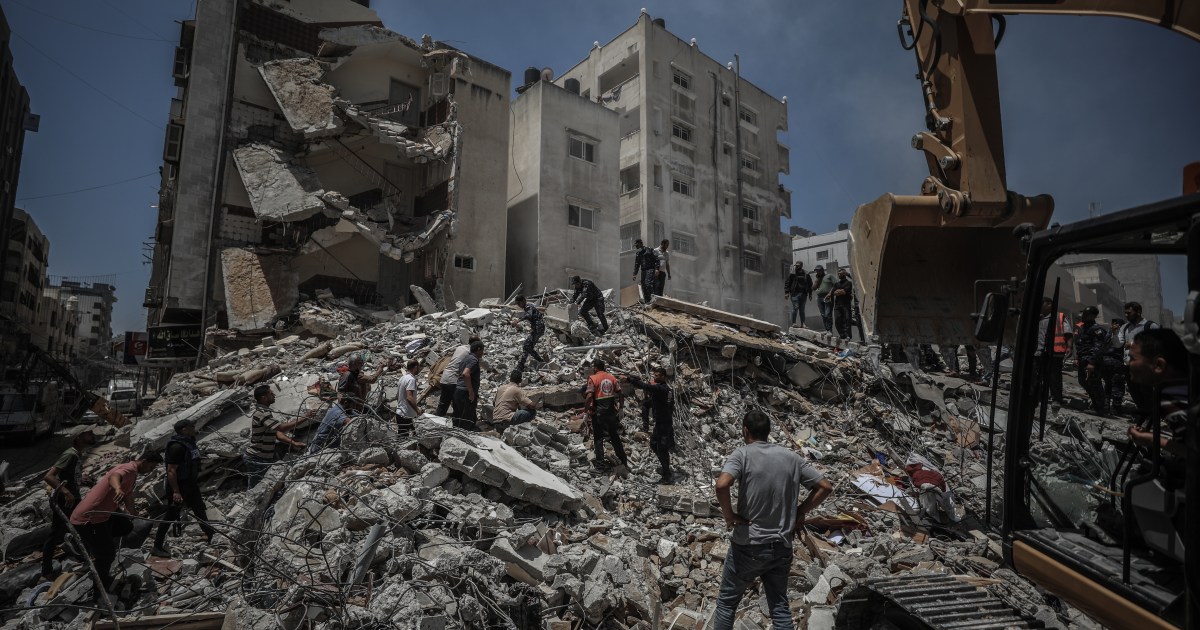After the entry into force of the unconditional ceasefire agreement between Israel and the Palestinian resistance factions, the traumatized families limit the horror of what happened in the Gaza Strip, including the devastation and loss of loved ones, with little hope for security and a return to normalcy.
With these words, the British newspaper "The Guardian" opened a report, in which it said that Gaza, the small coastal city, has been greatly distorted by the recent Israeli bombardment, so that the map of its streets, roads and landmarks, which was drawn in the minds of its residents only two weeks ago, is no longer as it was.
The newspaper continues that the shortcuts that car drivers used to take to avoid traffic jams, may no longer be valid, as potholes spread in the streets, rubble of dilapidated buildings blocking the roads, and tall buildings no longer exist.
And the continuous aerial bombardment on Gaza for 11 days caused the destruction of the city, and the ground shook violently until it seemed that the buildings were uprooted, as if they were not struck from above.
On one side of Al-Wehda Street stood a building housing Al-Shifa Hospital, the largest medical facility in Gaza.
And in it lay Amjad Murtaja, 40, with his feet covered with wounds.
Murtaja was inside his rented apartment on the fourth floor of Al Wahda Street when the missile struck the balcony.
Moan and scream
Recalling the scene that day, Murtaja tells the Guardian that the building was shaking, and all his thinking was focused on saving his wife and son.
He rushed to their room just in time to hold them before a second missile hit the building, which had completely collapsed.
The newspaper quotes Murtaja as saying that when he was stuck under the rubble of the building, he could hear his neighbors groaning and screaming.
For her part, Suzanne, the wife of Murtaja (36 years), said that when the building collapsed, she was upset, and she even thought at the time that a wardrobe fell on them.
But she managed to reach her mobile phone with her hand, not stuck in the rubble.
"I managed to turn on the light on the phone, so we realized that the building had collapsed," she added.
“We fell together,” Amjad says, and his wife Suzanne and his son (2 years old) were near him.
Amjad and his wife - who doctors later confirmed that she had suffered a broken back - remained trapped under the rubble for 4 hours before the neighbors and rescuers succeeded in pulling them out.
And Israel claimed that its goal in the attacks on Al-Wehda Street, last Sunday, was to destroy the vast network of tunnels, which it calls "the Hamas metro", while its army claimed that it did not intend to bring down the buildings.
After nearly a week of the raids, piles of concrete rubble are still strewn along Al-Wehda Street, yet all that remains of the building, in which the Murtaja family lived, is an inner ladder of 3 floors, and there stands a sign with the names of the bombing martyrs and the phrase "the massacre of Unity." ".
Another witness to what happened in the aforementioned building, Zakia Abu Dyer, 44, said that she and her husband and son lived in the next building.
She added that, on the eve of the bombing, she and her family had to move to the ground house of one of their relatives in the same street, thinking that they would be safe from any attack.
But two days later, while she and the other family members were eating dinner, a shell hit the house, and she said with her leg wrapped in a bandage, "There is no safe place ... the whole place sank into blackness."
As for her husband, who was a few meters away from her, he was killed - with one of his relatives (11 years) - after a shrapnel hit him in the head.
On the other side of the street stands the cracked structure of another building.
The Director General of International Cooperation at the Ministry of Health in Gaza, Abd al-Latif al-Hajj, says that the building used to be an old primary health care clinic, perhaps the oldest of its kind in the Strip.
Devastation and pestilence
At first glance, it appears that the clinic was bombed due to holes and blisters appearing on its walls and bits of debris the size of a football field that were strewn on the ground.
However, this is not the case. When a missile hit the building on the other side of the street, the two upper floors collapsed and then hit the clinic.
Al-Hajj said that the building was the main center for testing for the Coronavirus in Gaza, and medical personnel were working when the explosion occurred;
As a result, many of them were injured.
And he added that Gaza is already suffering from a dangerous outbreak of the pandemic, and other epidemics are expected.
According to United Nations statistics, the bombing of Gaza destroyed 260 buildings, and damaged about 53 schools, 6 hospitals and 11 primary health care centers, and nearly 800,000 people were displaced from their homes, while 10 times that number suffers from a shortage of drinking water.
The strip’s two million residents live in what they call “the largest prison in the world,” where more than 50% of them are unemployed, the health care system collapses, and residents sometimes suffer from toxic water supplies and constant power cuts.

